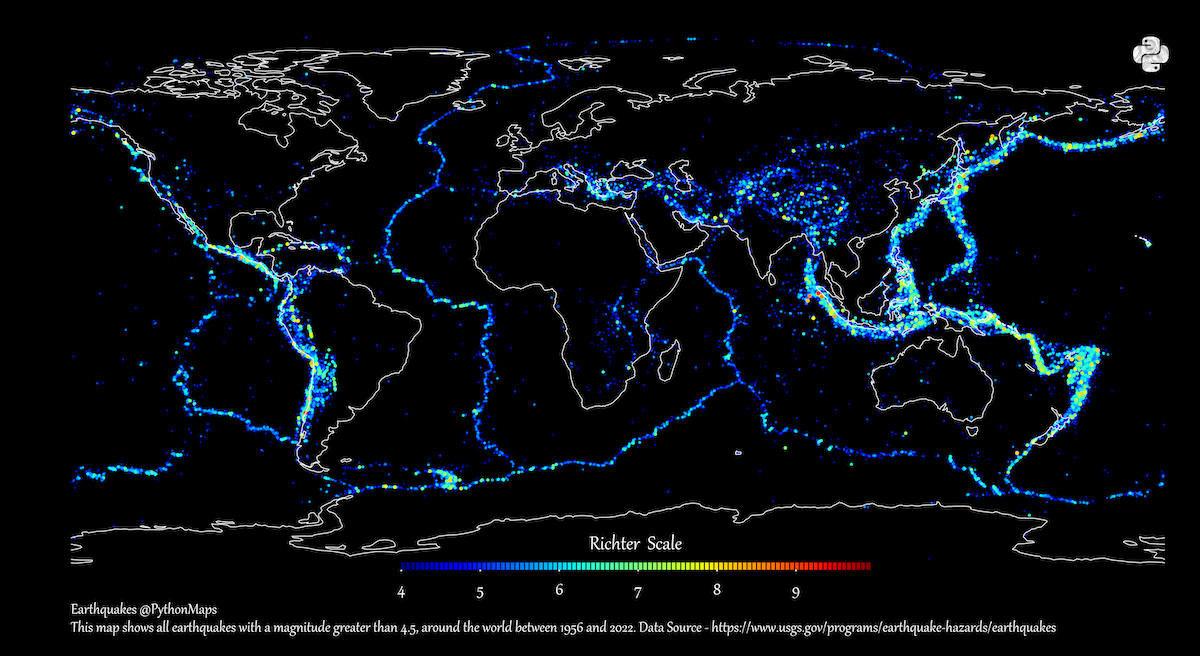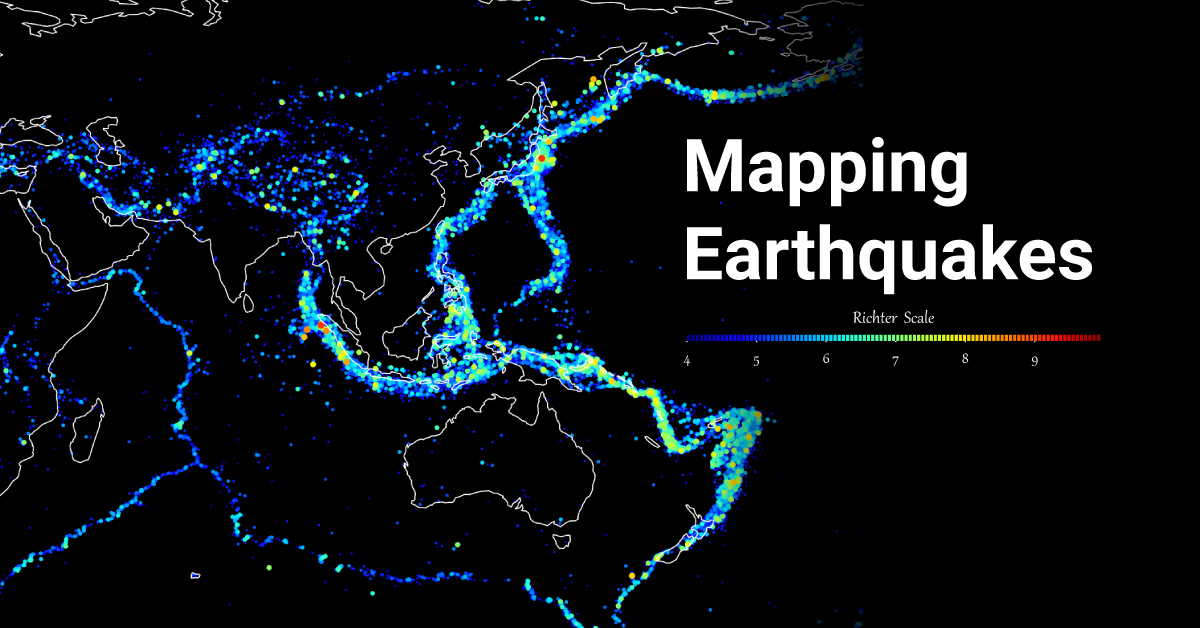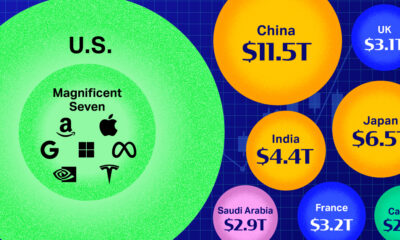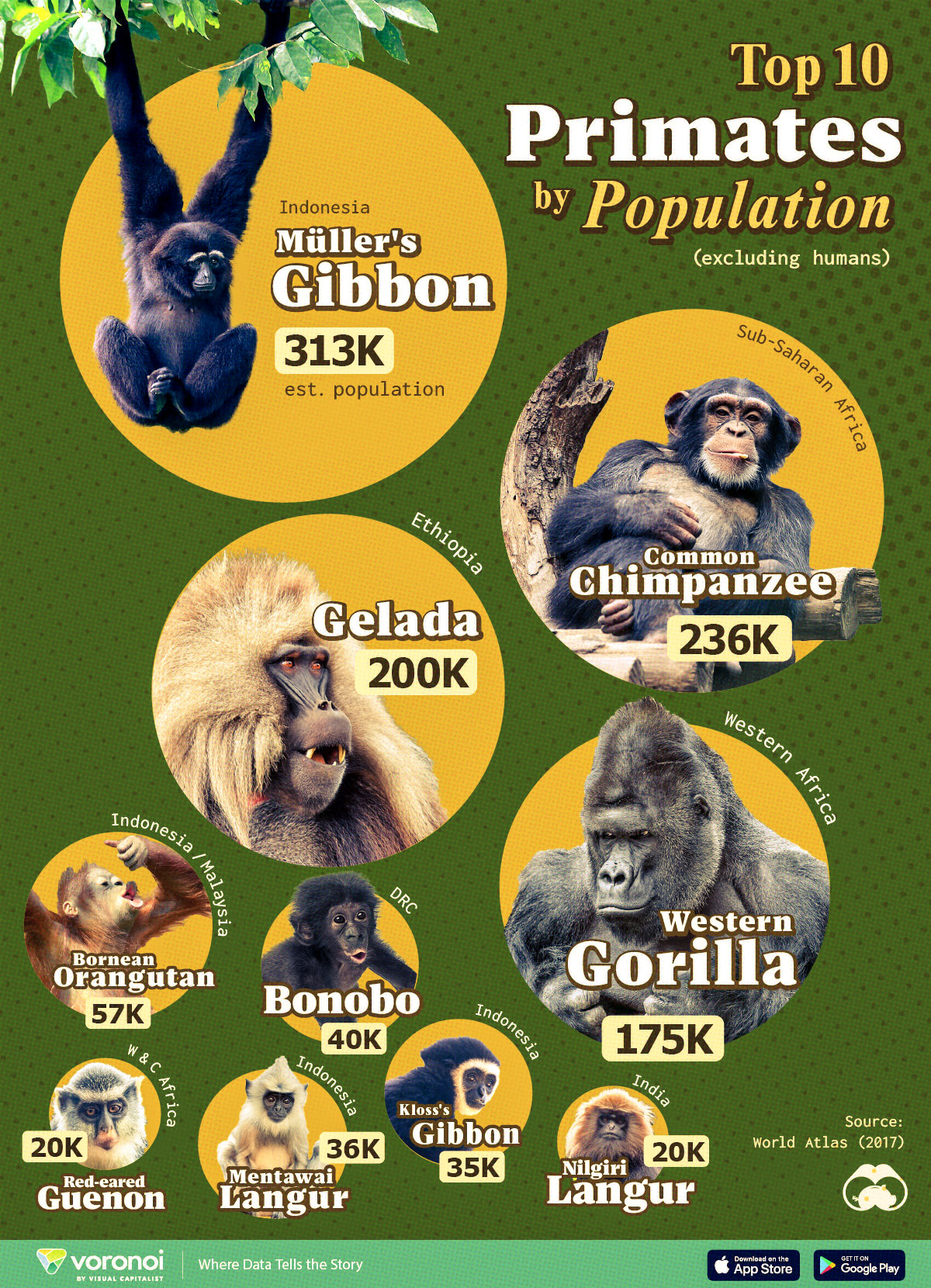Science
Mapped: The World’s Major Earthquakes from 1956‒2022
Click to view this graphic in a higher-resolution.
Mapping The World’s Major Earthquakes from 1956‒2022
Major earthquakes have occurred since time immemorial, but their observation and impact have not been evenly distributed around the globe.
On February 6, two earthquakes struck in Türkiye near the Syrian border. Both registered above a 7 on the Richter scale and have a combined death toll rapidly rising past 20,000 people.
And looking at the history of recent and ancient earthquakes, the location of these is no surprise. Using data from the United States Geological Survey (USGS), creator PythonMaps mapped earthquake epicenters between 1956 and 2022 that registered a 4.5 or higher on the Richter scale.
Tectonic Plate Movement and Earthquakes
Looking at the map, it’s easy to spot the concentration of earthquakes along the boundaries of Earth’s tectonic plates.
These massive moving slabs of rock fit together almost like puzzle pieces, making up the lithosphere or the upper crust. But as the edges of tectonic plates collide, slide against, and move away from each other, the crust cracks and folds and causes earthquakes.
Most of the earthquakes visualized on this map follow the boundaries of the seven major tectonic plates, along with the Philippine Plate (south of Japan) and the Nazca Plate (west of South America).
Here’s a list of the most earthquake-prone areas on the planet, according to the USGS.
| Earthquake Zones | Tectonic Plates | Locations |
|---|---|---|
| Ring of Fire | Pacific, North American, Philippine, Juan de Fuca, Cocos, Nazca | Rim of the Pacific Ocean. |
| Alpide Belt | Eurasian, African, Arabian, Indian | Java to Sumatra, through the Himalayas, west to the Mediterranean, and out into the Atlantic. |
| Mid-Atlantic Ridge | North American, Eurasian, South American, African | Deep underwater in the Atlantic, and directly underneath Iceland. |
According to academics, the recent earthquakes in Türkiye (part of the Alpide Belt) happened on multiple faults. The Arabian Plate likely moved northwards into the Eurasian Plate, pushing the Anatolian Plate (which Türkiye sits on) westward.
The Worst Earthquakes in History
Though earthquakes are spread around the world, major earthquakes seem even more tightly confined to specific regions.
These major earthquakes register highly on magnitude scales, such as the Richter scale (ML) and the newer and more commonly-used moment magnitude scale (Mw). These scales are logarithmic and ramp up quickly, so for the Richter scale, each whole number increase roughly corresponds to a 31.6-fold increase in energy released.
The map above sees a concentration of these bigger magnitude earthquakes congregating heavily around both sides of the Pacific Ocean. This border is also known colloquially as the “Ring of Fire” for its persistent volcanic activity, also caused by tectonic plate movement.
But the red points representing major earthquakes registering 9+ on the Richter scale are far and few between. Here’s a list of the 20 worst earthquakes in history, based on magnitude.
| Rank | Name | Magnitude | Location | Date (Y-M-D) |
|---|---|---|---|---|
| 1 | Valdivia Earthquake | 9.5 | Bio-Bio, Chile | 1960-05-22 |
| 2 | Good Friday Earthquake | 9.2 | Alaska, U.S. | 1964-03-28 |
| 3 | 2004 Indian Ocean Earthquake | 9.1 | Sumatra, Indonesia | 2004-12-26 |
| 4 | Tohoku Earthquake | 9.1 | Honshu, Japan | 2011-03-11 |
| 5 | 1952 Severo-Kurilsk Earthquake | 9.0 | Kamchatka, Russia | 1952-11-04 |
| 6 | Maule Earthquake | 8.8 | Bio-Bio, Chile | 2010-02-27 |
| 7 | 1906 Ecuador–Colombia Earthquake | 8.8 | Ecuador | 1906-01-31 |
| 8 | Rat Islands Earthquake | 8.7 | Alaska, U.S. | 1965-02-04 |
| 9 | Assam-Tibet Earthquake | 8.6 | Assam, Tibet | 1950-08-15 |
| 10 | 2012 Indian Ocean Earthquake | 8.6 | Sumatra, Indonesia | 2012-04-11 |
| 11 | Nias Earthquake | 8.6 | Sumatra, Indonesia | 2005-03-28 |
| 12 | 1957 Andreanof Islands Earthquake | 8.6 | Alaska, U.S. | 1957-03-09 |
| 13 | Unimak Island Earthquake, Alaska | 8.6 | Alaska, U.S. | 1946-04-01 |
| 14 | 1938 Banda Sea Earthquake | 8.5 | Banda Sea | 1938-02-01 |
| 15 | 1922 Vallenar Earthquake | 8.5 | Chile-Argentina Border | 1922-11-11 |
| 16 | 1963 Kuril Islands Earthquake | 8.5 | Kuril Islands, Russia | 1963-10-13 |
| 17 | 1923 Kamchatka Earthquake | 8.4 | Kamchatka, Russia | 1923-02-03 |
| 18 | September 2007 Sumatra Earthquakes | 8.4 | Sumatra, Indonesia | 2007-09-12 |
| 19 | Peru Earthquake | 8.4 | Southern Peru | 2001-06-23 |
| 20 | 1933 Sanriku Earthquake | 8.4 | Honshu, Japan | 1933-03-02 |
Areas near Indonesia, Russia, and Chile — all on tectonic plate boundaries — have seen half of the largest earthquakes recorded in history.
That said, there could have been earlier and larger earthquakes not recorded. Earlier civilizations lacked precise instruments to measure and document them and preserved written observations only, with some of the earliest records dating back nearly three millennia.
Can We Predict Major Earthquakes?
Despite the ability to measure both location and intensity of earthquakes (using a seismograph), scientists still cannot precisely predict exactly where, when, or at what magnitude an earthquake will occur.
However, they can measure the probability of an earthquake occurring, especially around fault zones. A famous example is “the big one” around the Cascadia subduction zone in North America which occurs every 200 to 800 years.
In areas that sit on fault lines between plates, earthquake preparedness can play a big role in mitigating risk.

This article was published as a part of Visual Capitalist's Creator Program, which features data-driven visuals from some of our favorite Creators around the world.
Science
What Are the 10 Most Common Primates in the World?
This list excludes humans, who would otherwise lead the ranks of most common primates by a significant margin.
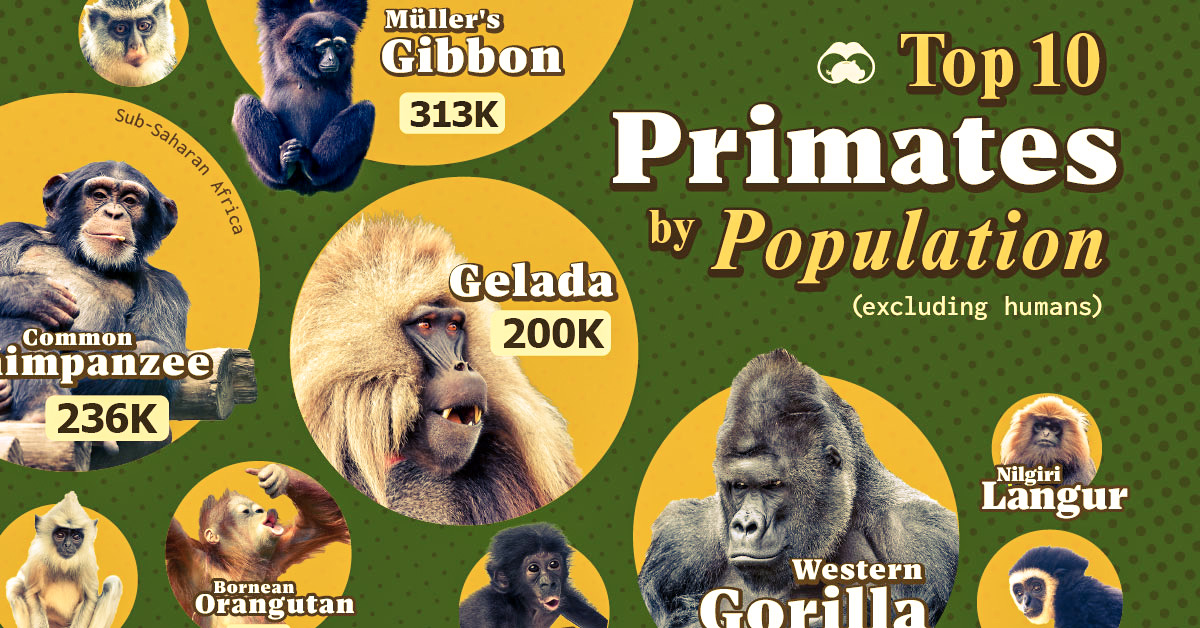
What Are the 10 Most Common Primates in the World?
This was originally posted on our Voronoi app. Download the app for free on Apple or Android and discover incredible data-driven charts from a variety of trusted sources.
The word ‘primate’ traces its roots back to the Latin word ‘primas,’ meaning ‘of first rank’ or the highest order in the animal kingdom. This classification intuitively reflects humans’ fascination with the many species who are our closest cousins.
In this graphic, we visualize the top 10 species of primates, ranked by their estimated global population. This data comes from WorldAtlas, and was last updated in 2017.
Given the difficult nature of tracking wild animals, these numbers should be treated as approximations rather than exact figures.
Ranked: Top 10 Primates, by Population
At the top of the list, there are more than 300,000 Müller’s Bornean Gibbons in the world, found on the island of Borneo in Indonesia and Malaysia.
The larger gibbon family consists of around 20 species of small apes found swinging through Southeast Asian rainforests. These acrobatic primates are known for their loud calls, impressive agility, and monogamous family structures.
Despite their ape status, they differ from great apes by being smaller and lacking nests.
| Rank | Monkey | Region of Origin | Estimated Population (as of 2017) |
|---|---|---|---|
| 1 | Muller's Bornean Gibbon | 🇮🇩 Indonesia | 312,500 |
| 2 | Common Chimpanzee | 🌍 Sub-Saharan Africa | 236,200 |
| 3 | Gelada | 🇪🇹 Ethiopia | 200,000 |
| 4 | Western Gorilla | 🌍 Western Africa | 175,000 |
| 5 | Bornean Orangutan | 🇮🇩 Indonesia / 🇲🇾 Malaysia | 57,000 |
| 6 | Mentawai Langur | 🇮🇩 Indonesia | 36,000 |
| 7 | Bonobo | 🇨🇩 DRC | 39,750 |
| 8 | Kloss's Gibbon | 🇮🇩 Indonesia | 35,000 |
| 9 | Red-eared Guenon | 🌍 West & Central Africa | 20,000 |
| 10 | Nilgiri Langur | 🇮🇳 India | 20,000 |
Ranked second, the Common Chimpanzee can be found in the savannas and forests of sub-Saharan Africa. A subspecies—the Eastern Chimpanzees in Tanzania’s Gombe National Park—were the primary focus of noted biologist Jane Goodall’s pioneering research in the 1960s.
Despite their apparent numbers, chimpanzees are now classified as an endangered species by the UN, their survival threatened by habitat loss, poaching, and disease.
All the way across, in Ethiopia, the Gelada species is the third most populous primate on the planet. Their short, stump fingers make them adept rock climbers—useful for navigating the Semien mountains they call home.
At fourth place, the Western Gorilla, also found in Africa, is the last primate species with a population above 100,000. The Western Gorillas are a little smaller than their Eastern counterparts, who are the largest living primates.
See More Animal Graphics From Visual Capitalist
If you’re curious to learn more about animals, check out this graphic that ranks the top speeds of the world’s fastest animals.
-

 Maps2 weeks ago
Maps2 weeks agoMapped: Average Wages Across Europe
-

 Money1 week ago
Money1 week agoWhich States Have the Highest Minimum Wage in America?
-

 Real Estate1 week ago
Real Estate1 week agoRanked: The Most Valuable Housing Markets in America
-

 Markets1 week ago
Markets1 week agoCharted: Big Four Market Share by S&P 500 Audits
-

 AI1 week ago
AI1 week agoThe Stock Performance of U.S. Chipmakers So Far in 2024
-

 Automotive1 week ago
Automotive1 week agoAlmost Every EV Stock is Down After Q1 2024
-

 Money2 weeks ago
Money2 weeks agoWhere Does One U.S. Tax Dollar Go?
-

 Green2 weeks ago
Green2 weeks agoRanked: Top Countries by Total Forest Loss Since 2001

